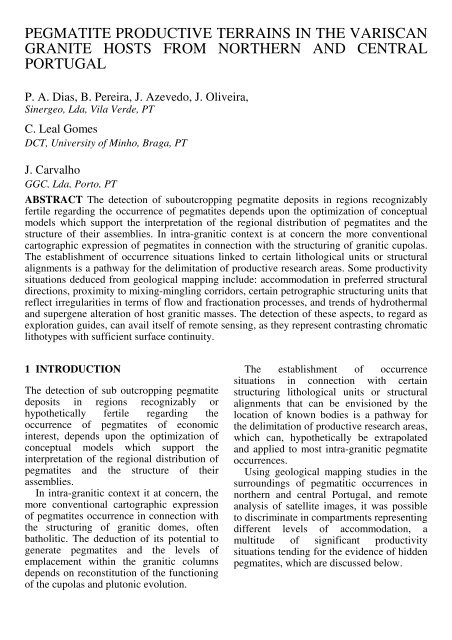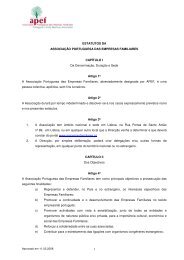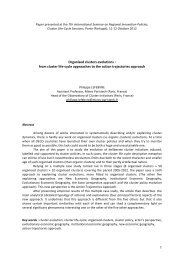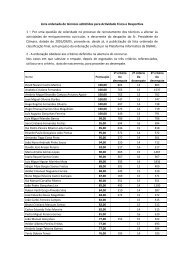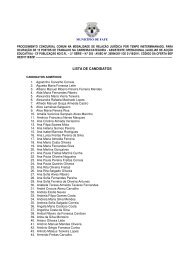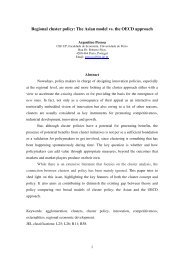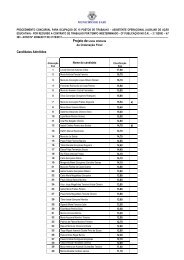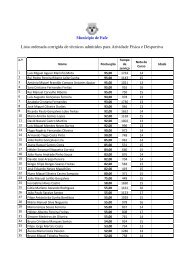pegmatite productive terrains in the variscan ... - TextoVirtual.com
pegmatite productive terrains in the variscan ... - TextoVirtual.com
pegmatite productive terrains in the variscan ... - TextoVirtual.com
You also want an ePaper? Increase the reach of your titles
YUMPU automatically turns print PDFs into web optimized ePapers that Google loves.
PEGMATITE PRODUCTIVE TERRAINS IN THE VARISCAN<br />
GRANITE HOSTS FROM NORTHERN AND CENTRAL<br />
PORTUGAL<br />
P. A. Dias, B. Pereira, J. Azevedo, J. Oliveira,<br />
S<strong>in</strong>ergeo, Lda, Vila Verde, PT<br />
C. Leal Gomes<br />
DCT, University of M<strong>in</strong>ho, Braga, PT<br />
J. Carvalho<br />
GGC, Lda, Porto, PT<br />
ABSTRACT The detection of suboutcropp<strong>in</strong>g <strong>pegmatite</strong> deposits <strong>in</strong> regions recognizably<br />
fertile regard<strong>in</strong>g <strong>the</strong> occurrence of <strong>pegmatite</strong>s depends upon <strong>the</strong> optimization of conceptual<br />
models which support <strong>the</strong> <strong>in</strong>terpretation of <strong>the</strong> regional distribution of <strong>pegmatite</strong>s and <strong>the</strong><br />
structure of <strong>the</strong>ir assemblies. In <strong>in</strong>tra-granitic context is at concern <strong>the</strong> more conventional<br />
cartographic expression of <strong>pegmatite</strong>s <strong>in</strong> connection with <strong>the</strong> structur<strong>in</strong>g of granitic cupolas.<br />
The establishment of occurrence situations l<strong>in</strong>ked to certa<strong>in</strong> lithological units or structural<br />
alignments is a pathway for <strong>the</strong> delimitation of <strong>productive</strong> research areas. Some productivity<br />
situations deduced from geological mapp<strong>in</strong>g <strong>in</strong>clude: ac<strong>com</strong>modation <strong>in</strong> preferred structural<br />
directions, proximity to mix<strong>in</strong>g-m<strong>in</strong>gl<strong>in</strong>g corridors, certa<strong>in</strong> petrographic structur<strong>in</strong>g units that<br />
reflect irregularities <strong>in</strong> terms of flow and fractionation processes, and trends of hydro<strong>the</strong>rmal<br />
and supergene alteration of host granitic masses. The detection of <strong>the</strong>se aspects, to regard as<br />
exploration guides, can avail itself of remote sens<strong>in</strong>g, as <strong>the</strong>y represent contrast<strong>in</strong>g chromatic<br />
lithotypes with sufficient surface cont<strong>in</strong>uity.<br />
1 INTRODUCTION<br />
The detection of sub outcropp<strong>in</strong>g <strong>pegmatite</strong><br />
deposits <strong>in</strong> regions recognizably or<br />
hypo<strong>the</strong>tically fertile regard<strong>in</strong>g <strong>the</strong><br />
occurrence of <strong>pegmatite</strong>s of economic<br />
<strong>in</strong>terest, depends upon <strong>the</strong> optimization of<br />
conceptual models which support <strong>the</strong><br />
<strong>in</strong>terpretation of <strong>the</strong> regional distribution of<br />
<strong>pegmatite</strong>s and <strong>the</strong> structure of <strong>the</strong>ir<br />
assemblies.<br />
In <strong>in</strong>tra-granitic context it at concern, <strong>the</strong><br />
more conventional cartographic expression<br />
of <strong>pegmatite</strong>s occurrence <strong>in</strong> connection with<br />
<strong>the</strong> structur<strong>in</strong>g of granitic domes, often<br />
batholitic. The deduction of its potential to<br />
generate <strong>pegmatite</strong>s and <strong>the</strong> levels of<br />
emplacement with<strong>in</strong> <strong>the</strong> granitic columns<br />
depends on reconstitution of <strong>the</strong> function<strong>in</strong>g<br />
of <strong>the</strong> cupolas and plutonic evolution.<br />
The establishment of occurrence<br />
situations <strong>in</strong> connection with certa<strong>in</strong><br />
structur<strong>in</strong>g lithological units or structural<br />
alignments that can be envisioned by <strong>the</strong><br />
location of known bodies is a pathway for<br />
<strong>the</strong> delimitation of <strong>productive</strong> research areas,<br />
which can, hypo<strong>the</strong>tically be extrapolated<br />
and applied to most <strong>in</strong>tra-granitic <strong>pegmatite</strong><br />
occurrences.<br />
Us<strong>in</strong>g geological mapp<strong>in</strong>g studies <strong>in</strong> <strong>the</strong><br />
surround<strong>in</strong>gs of pegmatitic occurrences <strong>in</strong><br />
nor<strong>the</strong>rn and central Portugal, and remote<br />
analysis of satellite images, it was possible<br />
to discrim<strong>in</strong>ate <strong>in</strong> <strong>com</strong>partments represent<strong>in</strong>g<br />
different levels of ac<strong>com</strong>modation, a<br />
multitude of significant productivity<br />
situations tend<strong>in</strong>g for <strong>the</strong> evidence of hidden<br />
<strong>pegmatite</strong>s, which are discussed below.
1.1 Tectonic-orogenic condition<strong>in</strong>g of <strong>the</strong><br />
emplacement of <strong>pegmatite</strong>s<br />
In North and Central Portugal most<br />
<strong>pegmatite</strong>s appear <strong>in</strong> a cartographic space<br />
more or less co<strong>in</strong>cident with <strong>the</strong> limits<br />
proposed by Lotze (1945) for <strong>the</strong> Central<br />
Iberian Zone (CIZ) of <strong>the</strong> Variscan Cha<strong>in</strong>.<br />
The Central Iberian Pegmatite Belt (CCI)<br />
(Leal Gomes & Nunes, 2003) corresponds to<br />
<strong>the</strong> en<strong>com</strong>pass<strong>in</strong>g unit set for <strong>the</strong> regional<br />
distribution of bodies and dykes <strong>in</strong> <strong>the</strong><br />
North and Centre of Portugal, which can<br />
hold all classes of <strong>pegmatite</strong>s discrim<strong>in</strong>ated<br />
by G<strong>in</strong>sburg et al. (1979) (Fig. 1). In this<br />
<strong>com</strong>partment, <strong>the</strong> regional division -<br />
<strong>pegmatite</strong> field - is <strong>the</strong> level of organization<br />
best suited to structurally discrim<strong>in</strong>ate<br />
<strong>pegmatite</strong>s (Leal Gomes & Nunes, 2003).<br />
In CCI, <strong>the</strong> <strong>pegmatite</strong>s are related to<br />
granitic <strong>in</strong>trusions associable to <strong>the</strong> Variscan<br />
Orogeny. Ages are close to those that<br />
characterize <strong>the</strong> granites – 300 Ma<br />
(evolution of older granites) and 290 Ma<br />
(later granites). The parental plutonites are<br />
syn-tectonic two-mica granites and late to<br />
post-tectonic biotite granites.<br />
In <strong>the</strong> f<strong>in</strong>al stages of <strong>the</strong> Variscan<br />
orogeny, are def<strong>in</strong>ed mega-scale corridors<br />
and ductile-brittle shear zones, subject to<br />
successive events of reactivation.<br />
Thus, <strong>the</strong> geometric configuration of <strong>the</strong><br />
fields is also <strong>in</strong>fluenced by horst-graben type<br />
displacements and adjustments, associated<br />
with major accidents parallel to <strong>the</strong> Vilariça<br />
type l<strong>in</strong>eaments (Fig.1).<br />
The diversity of <strong>pegmatite</strong>s represented<br />
here <strong>com</strong>es from metallogenic specialization<br />
of parental granites, magmatic fractionation<br />
trends of <strong>the</strong>ir more evolved terms and<br />
deformational conditions of <strong>in</strong>stallation<br />
environments (Leal Gomes & Nunes, 2003).<br />
Pegmatites hosted <strong>in</strong> granites, correspond<br />
to miarolitic ceramic <strong>pegmatite</strong>s, related to<br />
late to post-tectonic granites regard<strong>in</strong>g <strong>the</strong><br />
3rd phase of Variscan deformation (<strong>in</strong>tra-<br />
Westphalian, D3). In most cases <strong>the</strong>se are<br />
essentially biotite granites, medium to coarse<br />
gra<strong>in</strong>ed sometimes porphyroid.<br />
The sets and pegmatitic bodies acquire<br />
irregular shapes, or more regular geometries:<br />
A- Irregular miarolitic or massive bodies -<br />
related to diapir like mobilizations.<br />
B- Tabular bodies - related to <strong>in</strong>trusion<br />
<strong>in</strong>to cupolas de<strong>com</strong>pression bands <strong>in</strong><br />
upper levels of <strong>the</strong> crust, where <strong>the</strong>re<br />
is a prevalence of fragile conditions.<br />
Figure 1 – Position of <strong>pegmatite</strong> fields <strong>in</strong><br />
<strong>the</strong> Central Iberian Pegmatite Belt (CCI).<br />
Paleogeographic zonography to <strong>the</strong> West of<br />
<strong>the</strong> Iberian Pen<strong>in</strong>sula (adapted from Leal<br />
Gomes and Nunes, 2003).<br />
Leal Gomes & Nunes (2003) and<br />
Guimarães & Leal Gomes (2010), suggest a<br />
correlation between <strong>the</strong> dimensions and<br />
shapes of <strong>the</strong> <strong>pegmatite</strong> bodies and <strong>the</strong><br />
chronology of parental granite emplacement.<br />
1.2 Concerned <strong>pegmatite</strong> fields<br />
The <strong>in</strong>tra-granitic <strong>pegmatite</strong> fields of CCI,<br />
considered most useful for detect<strong>in</strong>g<br />
conspicuous <strong>pegmatite</strong> distribution<br />
organizations and relevant <strong>com</strong>positional<br />
properties of host granitic masses, capable of<br />
assist<strong>in</strong>g <strong>the</strong> detection of sub-outcropp<strong>in</strong>g<br />
<strong>pegmatite</strong> sets and bodies, and at <strong>the</strong> same<br />
time, able to cover a multitude of significant<br />
evidence situations, correspond to <strong>the</strong> areas<br />
of study: Ponte da Barca (Silva, 2002),<br />
Chaves (Pereira et al., 1998 and Pereira,
2005), Satão-Aguiar da Beira (Leal Gomes,<br />
Trabulo et al., 1995, Guimarães, 2012),<br />
Guarda-Belmonte (Silva et al., 2006, Ramos,<br />
1998; Correia Neves, 1960).<br />
The location and tectonic-orogenic<br />
condition<strong>in</strong>g of <strong>the</strong> studied pegmatitic fields<br />
and granitic areas are shown <strong>in</strong> Figure 2.<br />
Figure 2 – Identification of areas with<br />
studied granitic <strong>pegmatite</strong> fields. Location <strong>in</strong><br />
relation to <strong>the</strong> distribution of syn- and lateto<br />
post-tectonic Variscan granites. Legend as<br />
<strong>in</strong> Figure 1.<br />
There, are represented contrast<strong>in</strong>g<br />
granitoid types <strong>in</strong> contact, show<strong>in</strong>g specific<br />
aspects of <strong>the</strong> distribution of genetically<br />
related <strong>pegmatite</strong>s.<br />
Overall, <strong>the</strong>se express different levels of<br />
exhumation, morphological expression, and<br />
structural levels of swarms emplacement. In<br />
all cases, <strong>pegmatite</strong>s have cupolar location <strong>in</strong><br />
relation to <strong>the</strong> late-tectonic granites.<br />
The contrasts of <strong>the</strong> <strong>pegmatite</strong>s are<br />
manifested <strong>in</strong> <strong>the</strong> chemical typology, LCT<br />
and NYF, <strong>in</strong> <strong>the</strong> paragenetic and<br />
morphological diversity and, <strong>in</strong> respect of<br />
specific m<strong>in</strong>eralizations (Table 1).<br />
2 SITUATIONS OF ACCOMODATION<br />
AND ENTITIES RELATED TO THE<br />
CCI PEGMATITES<br />
Are here contemplated <strong>the</strong> more consistent<br />
geometric organizations of <strong>pegmatite</strong> bodies<br />
<strong>in</strong> relation with <strong>the</strong> ma<strong>in</strong> brittle-ductile<br />
deformation structures, <strong>the</strong> cartographic<br />
expression of <strong>pegmatite</strong>s relative to <strong>the</strong> host<br />
granites and certa<strong>in</strong> related petrographic<br />
abnormalities, which are apparent <strong>in</strong> <strong>the</strong><br />
studied <strong>pegmatite</strong> fields of <strong>the</strong> CCI.<br />
2.1 Structural and geomorphological<br />
patterns of <strong>pegmatite</strong>s emplacement<br />
The late-Variscan shear corridors correspond<br />
to polycyclic magma feed<strong>in</strong>g systems<br />
capable of transmitt<strong>in</strong>g <strong>the</strong> <strong>in</strong>stallation of<br />
<strong>pegmatite</strong> magmas, which evolve by gradual<br />
and direct "<strong>in</strong> situ" fractionation. The<br />
dra<strong>in</strong>age and ac<strong>com</strong>modation environments<br />
are fundamentally transtensive, formulated<br />
<strong>in</strong> ductile-brittle ruptures developed dur<strong>in</strong>g<br />
<strong>the</strong> consolidation of magmas, or result<strong>in</strong>g<br />
from reactivation of earlier structures,<br />
precocious <strong>in</strong> <strong>the</strong> structur<strong>in</strong>g of <strong>the</strong> Iberian<br />
Variscan Cha<strong>in</strong>.<br />
In nor<strong>the</strong>rn and central Portugal,<br />
directions NW-SE, NNE-SSW and ENE-<br />
WSW (see Fig. 2) and especially <strong>the</strong>ir<br />
<strong>in</strong>tersections, have decisive <strong>in</strong>fluence on<br />
<strong>pegmatite</strong> ac<strong>com</strong>modation and seem to<br />
control <strong>the</strong> alignment of <strong>pegmatite</strong> bodies.<br />
In <strong>the</strong> several <strong>pegmatite</strong> fields considered<br />
for study, <strong>the</strong> more consistent shears have<br />
N10-30ºE direction, observ<strong>in</strong>g <strong>the</strong> strict<br />
alignment of bodies under this direction.<br />
These should represent preferred percolation<br />
corridors, and may express paths l<strong>in</strong>k<strong>in</strong>g<br />
<strong>pegmatite</strong> bodies. Simultaneously, suggest<br />
that <strong>the</strong> emplacement is related to an episode<br />
more or less bounded on <strong>the</strong> evolution of <strong>the</strong><br />
regional stress field.<br />
In Chaves (Fig. 2), this direction also plays<br />
<strong>the</strong> role of transmitt<strong>in</strong>g post-tectonic<br />
magmas, <strong>in</strong> <strong>the</strong> last stages of transcurrent<br />
deformation, already <strong>in</strong> uplift<strong>in</strong>g, which<br />
should provide <strong>the</strong> felsic differentiated<br />
<strong>pegmatite</strong> magmas, which evolve from<br />
gravitational stratification panels, <strong>in</strong><br />
successive stages of granitic cupola collapse
- stocksheider <strong>pegmatite</strong>s with endogranite /<br />
exogranite <strong>com</strong>plex (Pereira et al., 1998 and<br />
Pereira, 2005).<br />
It is also deduced from <strong>the</strong> analysis of<br />
<strong>in</strong>tra-granitic fields, that <strong>the</strong> <strong>pegmatite</strong>s often<br />
have locations near elongated ridges, which<br />
are adjacent to cont<strong>in</strong>uous l<strong>in</strong>eaments. This<br />
topographic location should retract <strong>the</strong> ma<strong>in</strong><br />
structural doma<strong>in</strong>s of emplacement <strong>in</strong><br />
granitic domes.<br />
Table 1 – Emplacement doma<strong>in</strong>s and discrim<strong>in</strong>ation of morphologies, paragenesis and<br />
m<strong>in</strong>eralizations specific to <strong>the</strong> <strong>pegmatite</strong>s of CCI fields covered <strong>in</strong> this study.<br />
STUDIED AREAS<br />
*<br />
Emplacement<br />
doma<strong>in</strong>s<br />
Morphoscopy and<br />
morphometry<br />
PONTE DA<br />
BARCA<br />
CHAVES ALTO VOUGA GUARDA-BELMONTE<br />
Intra-granitic Peri-granitic Intra-granitic Peri-granitic Intra-granitic<br />
Irregular bodies<br />
(<strong>in</strong>verted drop<br />
and hourglass<br />
forms); tabular<br />
miarolitic bodies<br />
“Stocksheider”<br />
(related to granite<br />
cupola colapse)<br />
Irregular bodies<br />
(dumbbell,<br />
<strong>in</strong>verted drop,<br />
hourglass and<br />
spidery forms)<br />
Bodies related<br />
to granite<br />
cupola collapse<br />
and rooted sills<br />
Spidery<br />
irregular<br />
bodies<br />
Sills<br />
Typology<br />
Paradigmatic<br />
<strong>pegmatite</strong>s<br />
Typomorphic<br />
accessory<br />
paragenesis<br />
M<strong>in</strong>eralization<br />
Miarolitic<br />
Pedra da Moura,<br />
Dornas, Mata da<br />
Gal<strong>in</strong>heira,<br />
Brufe,<br />
Carvalheira,<br />
Covide<br />
- Fe, Mn,Li<br />
phosphates +<br />
Sphalerite,<br />
Arsenopyrite,<br />
Pyrite, Pyrrhotite,<br />
Ilmenite;<br />
- Beryl + Li<br />
muscovite +<br />
Tantalite +<br />
Zircon.<br />
Ti>Zn>As>(Li)<br />
Be>Li>Ta>Nb>Z<br />
r<br />
Hybrid miarolitic<br />
NYF-(LCT)<br />
Seixigal<br />
-Fluorapatite<br />
+Chlorite+Schorl<br />
- Cassiterite<br />
+Molibdenite+Ta<br />
ntite;<br />
- Fluorapatite+<br />
Phenakite+Bertra<br />
ndrite+OH-<br />
Herderite<br />
Mg<br />
Sn>Mo>Ta>Ti<br />
Be>Mo<br />
Hybrid miarolitic<br />
Senhora de<br />
Assunção, Vigia,<br />
Pestarenga,<br />
Corujeira, Vila<br />
Longa, Ventur<strong>in</strong>ha<br />
Beryl + Li-Fe-Mn-<br />
Al phosphates +<br />
sulphides + Nb-<br />
Ta-Ti-U oxides.<br />
Be > Nb > Ta<br />
> W > Mo ><br />
Li>Sn<br />
* correspond<strong>in</strong>g to <strong>pegmatite</strong> fields of <strong>the</strong> CCI. Location <strong>in</strong> Figure 2.<br />
Rare elements<br />
(LCT-petalitic)<br />
Rare<br />
elements<br />
(LCTlepidolitic)<br />
Alvarrões,<br />
Vela, Porto<br />
Tomé<br />
Queiriga-<br />
Lousadela<br />
Petalite+Lepido<br />
lite+spodumene<br />
+topaz+beryl+c<br />
assiterite+wolfr<br />
amite+Nb-Ta-<br />
Ti oxides +<br />
sulphides +<br />
sulphosalts +<br />
carbonates+<br />
fluorite.<br />
Li>Be>Sn><br />
Ta>Nb>W>Bi<br />
Hybrid<br />
Fonte da<br />
Cal,<br />
Bendada<br />
- Beryl +<br />
Columbitetantalite+<br />
Z<strong>in</strong>waldite<br />
+ loll<strong>in</strong>gite<br />
+ Fe-Mn<br />
phosphates<br />
Be ><br />
Nb > Ta ><br />
W > Mo ><br />
Li>Sn<br />
- Lepidolite<br />
+ topaz +<br />
tantalite +<br />
cassiterite +<br />
polilythionit<br />
e+ beryl<br />
Li>Ta><br />
Nb>Be>Sn><br />
Cs<br />
2.2 “Roof-pendants”, “stopped-blocks”,<br />
and magma mix<strong>in</strong>g corridors (mix<strong>in</strong>gm<strong>in</strong>gl<strong>in</strong>g<br />
processes)<br />
The pegmatitic productivity <strong>in</strong> some sectors<br />
appears to be related to contam<strong>in</strong>ation<br />
processes produced by <strong>the</strong> <strong>in</strong>teraction of<br />
different types of magma, dur<strong>in</strong>g <strong>the</strong> rise <strong>in</strong><br />
<strong>the</strong> chambers, or result<strong>in</strong>g from <strong>the</strong><br />
<strong>in</strong>corporation of portions of host rock, by<br />
collaps<strong>in</strong>g of <strong>the</strong> chambers roofs.<br />
At issue is <strong>the</strong> <strong>com</strong>positional<br />
hybridization by mix<strong>in</strong>g with more basic<br />
magmas and digestion of polygenic<br />
metamorphic rocks, result<strong>in</strong>g from <strong>the</strong><br />
transfer of “liquidus” depressors -<br />
hygromagmaphile and volatile elements – to<br />
<strong>the</strong> felsic magma, <strong>in</strong>creas<strong>in</strong>g its <strong>pegmatite</strong><br />
generat<strong>in</strong>g potential (Leal Gomes and<br />
Nunes, 2003).<br />
The proximity of <strong>the</strong> contam<strong>in</strong>ated cupola<br />
chamber is revealed by <strong>the</strong> presence of<br />
stopped-blocks and roof-pendants. The
<strong>in</strong>clusion or proximity to mix<strong>in</strong>g corridors is<br />
revealed by stripes of concentration or<br />
proliferation of enclaves. These are <strong>com</strong>mon<br />
<strong>in</strong> directions that seem to converge to <strong>the</strong><br />
pegmatitic bodies or constra<strong>in</strong> <strong>the</strong>ir<br />
alignment. They can take mega-scale<br />
expression, def<strong>in</strong><strong>in</strong>g magmatic flow patterns<br />
consistent with <strong>the</strong> trajectories of pegmatitic<br />
magmas <strong>in</strong>jection.<br />
Mix<strong>in</strong>g and contam<strong>in</strong>ation corridors are<br />
especially notable <strong>in</strong> <strong>the</strong> area of Ponte da<br />
Barca, where <strong>the</strong> most abundant enclaves,<br />
hosted <strong>in</strong> coarse gra<strong>in</strong> porphyroid granites<br />
are hyper-micaceous xenoliths and rounded<br />
to ellipsoidal heterogeneous enclaves with<br />
meso to melanocratic tendency, f<strong>in</strong>e-gra<strong>in</strong>ed<br />
with or without phenocrysts. F<strong>in</strong>e to medium<br />
gra<strong>in</strong> leucogranitic enclaves may be <strong>com</strong>mon<br />
<strong>in</strong> corridors established close to apical<br />
contacts between co-magmatic granites.<br />
2.3 Heterogeneities <strong>in</strong> granitic cupolas<br />
and petrographic signatures of apical<br />
fractionation and segregation trends<br />
Interface environments between granites,<br />
aris<strong>in</strong>g or not from cupola differentiation,<br />
appear to control <strong>the</strong> distribution of<br />
<strong>pegmatite</strong> swarms on its periphery.<br />
In <strong>the</strong> geographical areas discussed<br />
here<strong>in</strong>, <strong>the</strong> bodies appear to have a well<br />
def<strong>in</strong>ed relationship with <strong>the</strong>se <strong>in</strong>terfaces<br />
between two or more granite.<br />
Moreover, depend<strong>in</strong>g on <strong>the</strong> evolutive<br />
<strong>com</strong>plexity of <strong>the</strong> generator plutonite, are<br />
expressed structur<strong>in</strong>g lithologic units <strong>in</strong> host<br />
domes, which reflect irregularities <strong>in</strong> terms<br />
of flow processes and fractionation, show<strong>in</strong>g<br />
a greater pegmatitic productivity <strong>in</strong> <strong>the</strong>ir<br />
neighborhood.<br />
Some <strong>productive</strong> transitions on <strong>the</strong>se<br />
<strong>in</strong>terfaces could be discrim<strong>in</strong>ated and are<br />
marked by certa<strong>in</strong> fluidal configurations,<br />
petrographic fractionation and segregation<br />
trends that are discussed below.<br />
2.3.1 Leucocratic fácies with low<br />
granulometry and strong evidence of<br />
granitic differentiation<br />
Often pegmatitic bodies are concentrated <strong>in</strong><br />
areas with strong evidence of granitoid<br />
differentiation towards more leucocratic<br />
systems.<br />
Transitional terms of fractionation,<br />
correspond to f<strong>in</strong>e gra<strong>in</strong>ed leucogranites and<br />
felsic <strong>com</strong>posites of granite with graphic<br />
<strong>pegmatite</strong> with coarse, radial and fea<strong>the</strong>ry<br />
micaceous <strong>in</strong>tergrowths. The transitional<br />
granites can <strong>the</strong>n evolve to <strong>pegmatite</strong>s <strong>in</strong><br />
bands and pockets, and suffer <strong>in</strong>ternal<br />
fractionation, potentially generator of<br />
zonality.<br />
Lithological masses of this k<strong>in</strong>d are<br />
observed <strong>in</strong> most <strong>in</strong>tra-granitic <strong>pegmatite</strong><br />
groups studied.<br />
In markedly hyper-alum<strong>in</strong>ous<br />
environments, possibly contam<strong>in</strong>ated<br />
through contact with metapelitic host rocks,<br />
<strong>the</strong>se granites present garnet and cordierite<br />
and <strong>the</strong> fractionated and affiliated,<br />
morphologically evolved <strong>pegmatite</strong>s,<br />
manifest abundant andalusite and Al<br />
phosphates.<br />
2.3.1 Penetrative l<strong>in</strong>eations marked by <strong>the</strong><br />
fluidal planar alignment of potassic<br />
megafeldspars<br />
L<strong>in</strong>eations correspond<strong>in</strong>g to fluidalities<br />
established at low viscosity, assume<br />
approximately aureolar and cupular<br />
cartographic relation to <strong>the</strong> surround<strong>in</strong>g<br />
granites. Its attitude, usually ac<strong>com</strong>panies<br />
<strong>the</strong> topography of <strong>the</strong> apical contact. The<br />
distribution of <strong>pegmatite</strong>s is often co<strong>in</strong>cident<br />
with <strong>the</strong> surround<strong>in</strong>g boundaries of<br />
proliferation of <strong>the</strong>se fluidalities which can<br />
express upward ballon<strong>in</strong>g plumes<br />
organization sectioned by erosion (Pereira et<br />
al., 2012).<br />
The most typical fluidal aspects, are<br />
marked by l<strong>in</strong>ear and planar alignment of<br />
small potassium feldspar phenocrysts, with<br />
very high aspect ratio.<br />
The k<strong>in</strong>ematic <strong>in</strong>terpretation of <strong>the</strong><br />
geometric arrangement of feldspar<br />
phenocrysts may be functional for <strong>the</strong><br />
establishment of magmatic flow <strong>com</strong>ponents<br />
and reveal paths connect<strong>in</strong>g <strong>pegmatite</strong><br />
bodies, constra<strong>in</strong>ed by <strong>the</strong> topography of <strong>the</strong><br />
granitic cupolas. Namely, <strong>in</strong> Ponte da Barca,<br />
granitic masses with fluidalities have
sufficient cont<strong>in</strong>uity to be useful <strong>in</strong><br />
<strong>pegmatite</strong>s exploration, observ<strong>in</strong>g <strong>the</strong> mass<br />
expansion, and <strong>the</strong> proliferation of granitic<br />
pegmatoid structures and diffuse pegmatitic<br />
differentiations <strong>in</strong> <strong>in</strong>terfaces between<br />
different lithologic terms.<br />
2.3.2 Cluster<strong>in</strong>g phenomena of K-feldspar<br />
megacrysts <strong>in</strong> <strong>the</strong> granite host rocks<br />
Agglomerations of K-feldspar megacrysts<br />
are also <strong>com</strong>mon <strong>in</strong> granites immediately<br />
host<strong>in</strong>g <strong>pegmatite</strong>s. These are possibly<br />
determ<strong>in</strong>ed by a higher rate of crystallization<br />
of <strong>the</strong> granitic mass, and a relatively higher<br />
viscosity or represent cumulated<br />
organizations <strong>in</strong>fluenced by physical<br />
separation <strong>in</strong> conditions of mobility of<br />
liquids. These surfaces with density or<br />
rigidity contrast usually manifest vertical<br />
tendency sub-parallel to <strong>the</strong> attitude of some<br />
shear zones, suggest<strong>in</strong>g <strong>the</strong> <strong>in</strong>fluence of <strong>the</strong><br />
D3 stress field on <strong>the</strong> emplacement of<br />
granites and affiliated <strong>pegmatite</strong>s.<br />
In <strong>the</strong> area of Viseu (Alto Vouga<br />
<strong>pegmatite</strong> field, Fig. 2), <strong>the</strong>se sett<strong>in</strong>gs are<br />
<strong>com</strong>mon <strong>in</strong> <strong>the</strong> porphyroid facies proximal<br />
to some bodies.<br />
2.3.3 “Filter-press<strong>in</strong>g” phenomena<br />
Often <strong>the</strong> contact between granitic facies<br />
aris<strong>in</strong>g from cupola differentiation expresses<br />
enrichment <strong>in</strong> ferromagnesian constituents,<br />
ma<strong>in</strong>ly biotite. These represent side<br />
segregations by removal of felsic<br />
constituents by filter-press<strong>in</strong>g (<strong>com</strong>pare to<br />
We<strong>in</strong>berg et al., 2001), and have banded and<br />
schlierenitic aspect, with coarse gra<strong>in</strong> size.<br />
The proximity to fluidal organization units<br />
suggests that possibilities of segregation are<br />
strongly <strong>in</strong>fluenced by <strong>the</strong> mobility of<br />
liquids.<br />
Relationships such as <strong>the</strong>se are<br />
contemplated <strong>in</strong> <strong>in</strong>terfaces between<br />
porphyroid granites and f<strong>in</strong>e gra<strong>in</strong>ed<br />
differentiated leucogranites, as for example<br />
<strong>in</strong> Ponte da Barca, where <strong>the</strong> modal content<br />
of biotite <strong>in</strong> schlierenitic bands with<br />
thickness greater than 1 m, may exceed 80%.<br />
Less penetrative schlierenitic aspects are<br />
also observed <strong>in</strong> most granites host<strong>in</strong>g<br />
<strong>pegmatite</strong>s, <strong>in</strong> <strong>the</strong> o<strong>the</strong>r geographical areas.<br />
2.3.4 “Bubbl<strong>in</strong>g” phenomena<br />
The early stages of pegmatitic <strong>in</strong>stallation<br />
can be characterized by <strong>the</strong> rise of fluid<br />
bubbles <strong>in</strong> <strong>the</strong> host granitic cupolas. Result<br />
from magmas with culm<strong>in</strong>at<strong>in</strong>g enrichment<br />
<strong>in</strong> volatiles that tend quickly to<br />
supersaturation at low crystallization rate.<br />
The degass<strong>in</strong>g phenomena and mobilization<br />
would be facilitated by relatively rapid<br />
de<strong>com</strong>pression and cool<strong>in</strong>g of <strong>the</strong> granite<br />
host (e.g. Peretyazhko, 2010).<br />
In a subsequent evolutionary stage of<br />
pegmatitic differentiates dra<strong>in</strong>age, bubbles<br />
can form pockets morphologically and<br />
paragenetically more evolved (Guimarães,<br />
2012 and Leal Gomes & Nunes, 2003).<br />
In <strong>the</strong> area of Viseu (Fig. 2), <strong>the</strong> freez<strong>in</strong>g<br />
of <strong>the</strong> ascensional process, resulted <strong>in</strong> <strong>the</strong><br />
crystallization of myriads of bubble-like<br />
<strong>pegmatite</strong>s with a volume of a few cubic<br />
centimeters <strong>in</strong> a f<strong>in</strong>e gra<strong>in</strong>ed leucogranite.<br />
The spheres and ellipsoids are miarolitic,<br />
and distributed below <strong>the</strong> topographic level<br />
of emplacement of Senhora de Assunção<br />
<strong>pegmatite</strong> (Tab.1).<br />
2.4 Patterns of hydro<strong>the</strong>rmal and<br />
supergene alteration of <strong>productive</strong><br />
granitic masses<br />
Trends of yellow<strong>in</strong>g of <strong>the</strong> granitic mass,<br />
caused by supergene leach<strong>in</strong>g of Fe from<br />
biotite and garnet crystals, are observed<br />
frequently <strong>in</strong> <strong>the</strong> vic<strong>in</strong>ity of pegmatitic<br />
bodies, particularly <strong>in</strong> relation to<br />
leucogranitic transitional facies. The biotites<br />
are discolored and cloritized, occurr<strong>in</strong>g<br />
consistently <strong>the</strong> late fixation of Fe <strong>in</strong> <strong>the</strong><br />
form of vacuolar replenishments.<br />
Epidotization can also be widespread<br />
along major shear structures that control <strong>the</strong><br />
ac<strong>com</strong>modation of pegmatitic differentiates.<br />
In particular, directions N30ºE and ENE-<br />
WSW, considered determ<strong>in</strong>ant of<br />
ac<strong>com</strong>modation and upward mobilization of<br />
residual differentiates can, <strong>in</strong> face of
subsequent reactivations, present epidote<br />
and <strong>in</strong>fluence its concentration <strong>in</strong> proximal<br />
granites and <strong>pegmatite</strong>s.<br />
The most pervasive redden<strong>in</strong>g is typical of<br />
<strong>the</strong> peripheries of mix<strong>in</strong>g corridors,<br />
observ<strong>in</strong>g <strong>in</strong> coarse gra<strong>in</strong>ed porphyroid<br />
granitic facies <strong>the</strong> red shad<strong>in</strong>g, both of<br />
megacrysts and matrix.<br />
Phenomena of albitisation of granitic host<br />
masses are very rare. The fluids that<br />
orig<strong>in</strong>ate replacement units <strong>in</strong> <strong>the</strong> later<br />
stages of <strong>the</strong> evolution of <strong>pegmatite</strong>s, not<br />
normally extend beyond <strong>the</strong> contours of <strong>the</strong><br />
bodies and tabular boxes.<br />
Table 2 –Ac<strong>com</strong>modation situations and entities related to <strong>the</strong> <strong>pegmatite</strong>s of CCI <strong>in</strong>tragranitic<br />
fields: Ponte da Barca, Chaves, Alto Vouga and Guarda-Belmonte.<br />
PEGMATITE FIELDS<br />
EXPLORATION GUIDES<br />
PONTE DA BARCA CHAVES ALTO VOUGA<br />
GUARDA-<br />
BELMONTE<br />
Structural and<br />
geomorphological patterns<br />
NW-SE to ESE-WNW,<br />
N30ºE<br />
N30ºE<br />
N30ºE conjugated with<br />
E-W<br />
N20ºE conjugated<br />
with E-W<br />
Mix<strong>in</strong>g-m<strong>in</strong>gl<strong>in</strong>g processes Mix<strong>in</strong>g-m<strong>in</strong>gl<strong>in</strong>g corridors. Doma<strong>in</strong>s with<br />
“magmatic stopp<strong>in</strong>g”<br />
and “roof-pendants” .<br />
Heterogeneities <strong>in</strong> granitic cupolas and petrographic signatures of apical fractionation and segregation trends<br />
Leucocratic facies with low<br />
granulometry and strong<br />
evidence of granitic<br />
differentiation<br />
F<strong>in</strong>e-gra<strong>in</strong>ed leucogranites<br />
with garnet and cordierite;<br />
pegmatoid leucogranites<br />
with coarse, radial and<br />
fea<strong>the</strong>ry micaceous<br />
<strong>in</strong>tergrowths.<br />
F<strong>in</strong>e-gra<strong>in</strong>ed<br />
leucogranites; graphic<br />
leucogranites with<br />
coarse, radial and<br />
fea<strong>the</strong>ry micaceous<br />
<strong>in</strong>tergrowths.<br />
Heterogeneous<br />
granites with<br />
rounded quartz;<br />
pegmatoid<br />
leucogranites.<br />
Penetrative l<strong>in</strong>eations marked<br />
by <strong>the</strong> fluidal planar<br />
alignment of potassic<br />
megafeldspars<br />
L<strong>in</strong>ear and plan-l<strong>in</strong>ear<br />
concentric fluidalities.<br />
Cluster<strong>in</strong>g phenomena of K-<br />
feldspar megacrysts<br />
K-feldspar megacrysts<br />
agglomerations with<br />
vertical trend.<br />
“Filter-press<strong>in</strong>g” phenomena<br />
Exuberant shlieren between<br />
porphyroid granites and<br />
garnet-cordierite bear<strong>in</strong>g<br />
leucogranites.<br />
Frequent with<strong>in</strong><br />
porphyroid granites and<br />
<strong>in</strong>terfaces with f<strong>in</strong>egra<strong>in</strong>ed<br />
leucogranites.<br />
Occasional on <strong>the</strong><br />
periphery of<br />
transitional<br />
leucogranites.<br />
“Bubbl<strong>in</strong>g” phenomena Miarolitic bubble-like<br />
<strong>pegmatite</strong>s: spheres and<br />
ellipsoids with small<br />
volume.<br />
Patterns of hydro<strong>the</strong>rmal and<br />
supergene alteration of<br />
<strong>productive</strong> granitic masses<br />
Yellow<strong>in</strong>g and redden<strong>in</strong>g.<br />
Peri-pegmatitic<br />
banded<br />
albitisation.<br />
Epidotization Yellow<strong>in</strong>g and<br />
redden<strong>in</strong>g
3 REMOTE EXPRESSION IN<br />
SATELLITE IMAGES<br />
The lack of consistent physical and chemical<br />
contrasts <strong>in</strong> relation to granitic host rocks,<br />
<strong>com</strong>plicates <strong>the</strong> geophysical and<br />
geochemical exploration of <strong>in</strong>tra-granitic<br />
pegmatitic bodies.<br />
Lately, remote sens<strong>in</strong>g us<strong>in</strong>g satellite<br />
imagery is beg<strong>in</strong>n<strong>in</strong>g to be explored as a way<br />
for <strong>the</strong> exploration of outcropp<strong>in</strong>g bodies<br />
(Silva, 2009). The m<strong>in</strong>eralogical<br />
characteristics of residual magmatic<br />
<strong>com</strong>posites make viable its detection <strong>in</strong><br />
hyperspectral images.<br />
3.1 Valuation of remote sens<strong>in</strong>g analysis<br />
<strong>in</strong> <strong>the</strong> context of exploration of hidden<br />
<strong>pegmatite</strong>s<br />
When equat<strong>in</strong>g <strong>the</strong> identification of new<br />
hidden shallow deposits, geological<br />
exploration, especially structural analysis of<br />
<strong>pegmatite</strong>s and rocks <strong>in</strong> its vic<strong>in</strong>ity, seems to<br />
be <strong>the</strong> most susta<strong>in</strong>able path (Leal Gomes,<br />
2010; Guimarães, 2012). From <strong>the</strong><br />
organization of attitudes, shapes and <strong>in</strong>ternal<br />
structures of <strong>the</strong> deposits and host masses,<br />
are deduced three dimensional conceptual<br />
models, which can be extrapolated assum<strong>in</strong>g<br />
predictive efficacy (Leal Gomes, 2010).<br />
The diversity of situations deduced <strong>in</strong> this<br />
work, support useful models <strong>in</strong> exploration.<br />
These have utility for def<strong>in</strong><strong>in</strong>g levels of<br />
emplacement of <strong>pegmatite</strong>s <strong>in</strong> <strong>the</strong> granitic<br />
cupolas, and from a conceptual po<strong>in</strong>t of<br />
view, are <strong>in</strong> pr<strong>in</strong>ciple usable by remote<br />
sens<strong>in</strong>g, as <strong>the</strong>y represent extreme and<br />
contrast<strong>in</strong>g chromatic types with sufficient<br />
cont<strong>in</strong>uity <strong>in</strong> <strong>the</strong> surface (length and width).<br />
The chromatic thresholds of <strong>the</strong> contacts<br />
(granite) / (<strong>pegmatite</strong>) or (granite) / (granite<br />
with peculiar structuration units) expressed<br />
<strong>in</strong> <strong>the</strong> prior <strong>in</strong>ventory of productivity<br />
situations are <strong>the</strong> follow<strong>in</strong>g: fractionated<br />
granites with low granulometry and marked<br />
felsitic <strong>com</strong>position, clear; segregations and<br />
facies result<strong>in</strong>g from contam<strong>in</strong>ation and<br />
mix<strong>in</strong>g with high modal expression of mafic<br />
ferromagnesian constituents, dark; trends of<br />
hydro<strong>the</strong>rmal and supergene alteration<br />
promote yellow<strong>in</strong>g, redden<strong>in</strong>g and greenish<br />
colorations.<br />
Besides <strong>the</strong> chromatic effect, also <strong>the</strong><br />
conspicuous structural organization of <strong>the</strong>se<br />
targets is usable <strong>in</strong> conjunction, to <strong>the</strong><br />
delimitation of favorable areas for<br />
exploration.<br />
3.2 Usefulness of process<strong>in</strong>g satellite<br />
images for remote evidence of exploration<br />
guides<br />
The previous <strong>in</strong>ventory of productivity<br />
situations, serves geological exploration of<br />
sub-outcropp<strong>in</strong>g deposits <strong>in</strong> strategic and<br />
tactical steps.<br />
By provid<strong>in</strong>g coherent textural and<br />
chromatic contrasts, exploration may resort<br />
to remote sens<strong>in</strong>g, exist<strong>in</strong>g <strong>in</strong>clusively<br />
possibilities of evidence <strong>in</strong> constra<strong>in</strong>ed<br />
spectral images such as those result<strong>in</strong>g from<br />
Landsat.<br />
Methodologically, filtered images<br />
subjected to any type of ma<strong>the</strong>matical<br />
process<strong>in</strong>g, are more effective and functional<br />
<strong>in</strong> <strong>the</strong> analysis of <strong>the</strong> surface. Such analysis<br />
has been susta<strong>in</strong>ed with <strong>the</strong> software<br />
SPRING (Camara et al., 1996); among <strong>the</strong><br />
most reveal<strong>in</strong>g tests are:<br />
- directional filter<strong>in</strong>g –for evidence of shear<br />
networks and <strong>the</strong>ir po<strong>in</strong>ts of <strong>in</strong>tersection,<br />
where are receptioned pegmatitic<br />
differentiates.<br />
- Pr<strong>in</strong>cipal <strong>com</strong>ponent analysis – for<br />
evidence of anomalous lithological units<br />
with important spectral contrast relative to<br />
host rocks, which may correspond to<br />
exploration guides for <strong>pegmatite</strong>s.<br />
- Maxver classification (maximum likelihood<br />
algorithm) – for extrapolation to <strong>the</strong> region<br />
of spectral configurations correlated with<br />
<strong>pegmatite</strong>s.<br />
Also equates on a next phase, <strong>the</strong><br />
determ<strong>in</strong>ation of field spectral parameters<br />
representative of <strong>the</strong> described petrographic<br />
entities, us<strong>in</strong>g a spectroradiometer.<br />
This survey should reflect a greater<br />
diversity of situations and possibilities of<br />
remote detection by permitt<strong>in</strong>g <strong>the</strong><br />
establishment of quantitative relationships<br />
between <strong>pegmatite</strong>s exploration guides and<br />
its expression <strong>in</strong> satellite images.
It is expected to expand <strong>the</strong> pegmatitic<br />
and related entities spectral database, and<br />
ultimately ref<strong>in</strong>e and standardize procedures<br />
for exploration, through remote sens<strong>in</strong>g, of<br />
irregular and tabular bodies situated <strong>in</strong> <strong>in</strong>tragranitic<br />
context, with operational use<br />
analogous to geophysical and geochemical<br />
methods.<br />
ACKOWLEDGEMENTS<br />
This contribution results from work undertaken<br />
with<strong>in</strong> <strong>the</strong> project PROSPEG (ref. 11480,<br />
www.prospeg.org), co-supported by <strong>the</strong> “ON.2 – O<br />
Novo Norte” and QREN through <strong>the</strong> European<br />
Regional Development Fund (ERDF)<br />
REFERENCES<br />
Camara, G., Souza, R.C.M., Freitas, U.M., Garrido,<br />
J., 1996. Integrat<strong>in</strong>g remote sens<strong>in</strong>g and GIS by<br />
object-oriented data model<strong>in</strong>g. Computers &<br />
Graphics, vol. 20, 3, pp. 395-403.<br />
Correia Neves, J., 1960. Pegmatitos <strong>com</strong> berilo,<br />
columbite-tantalite e fosfatos da Bendada<br />
(Sabugal, Guarda). Memórias e Notícias, Museu e<br />
Laboratório M<strong>in</strong>eralógico e Geológico da<br />
Universidade de Coimbra, Coimbra, 50, 163 p.<br />
G<strong>in</strong>sburg, A. I., Timofeyev, I. N., Feldman, L. G.,<br />
1979. Pr<strong>in</strong>ciples of Geology of <strong>the</strong> granitic<br />
<strong>pegmatite</strong>s, Nedra, Moscovo.<br />
Guimarães, D., Leal Gomes, C., 2010. Evolução de<br />
forma e implantação de pegmatitos <strong>in</strong>tragraníticos<br />
Variscos – N de Portugal. I -<br />
dispositivos ascensionais. e-Terra, Geosciences<br />
on-l<strong>in</strong>e Journal, Geotic, vol. 11.<br />
Guimarães, D., 2012. C<strong>in</strong>emática da mobilidade<br />
pegmatítica em enxames epi a mesocorticais :<br />
modelos conceptuais aplicados à prospecção,<br />
Tese de Mestrado, Univ. M<strong>in</strong>ho, Braga, 104 p.<br />
Leal Gomes, C., Nunes, J. E. L., 2003. Análise<br />
paragenética e classificação dos pegmatitos<br />
graníticos da C<strong>in</strong>tura Hercínica Centro-Ibérica. A<br />
Geologia de Engenharia e os Recursos<br />
Geológicos, Coimbra – Imprensa da<br />
Universidade, vol. II, pp. 85-109.<br />
Leal Gomes, C., 2010. Distribuição espacial dos<br />
recursos de materiais cerâmicos pegmatíticos no<br />
noroeste de Portugal – Matriz orogénica e<br />
metalogénese relacionada. In: Ciências<br />
Geológicas – Ens<strong>in</strong>o e Investigação e sua<br />
História, vol. II, pp. 25-35.<br />
Lotze, F. (1945) - Zur Gliederung der Varisciden der<br />
Iberishen Meseta. Geoteckt Forsch, 6, pp. 78-92.<br />
Pereira, B., Azevedo, J., Oliveira, J., Dias, P. A.,<br />
Leal Gomes, C., Carvalho, J., Marques, A., 2012.<br />
Contributos da detecção remota para a evidência e<br />
localização de pegmatitos em contexto <strong>in</strong>tragranítico<br />
– Ponte da Barca (M<strong>in</strong>ho). In:<br />
Qu<strong>in</strong>ta‐ Ferreira, M., Barata, M. T., Lopes, F.C.,<br />
Andrade, A. I., Henriques, M. H., Pena dos Reis,<br />
R., Ivo Alves, E. (Coords). Para Desenvolver a<br />
Terra, Memórias e Notícias de Geociências no<br />
Espaço Lusófono, Imprensa da Universidade de<br />
Coimbra, cap. 51 (<strong>in</strong> press).<br />
Pereira, M.F., 2004. Organização estrutural e<br />
m<strong>in</strong>eralógica do aparelho pegmatítico de Pereira<br />
de Selão (Seixigal) – Vidago (N de Portugal),<br />
Tese de doutoramento, Univ. Téc. Lisboa, 393 p.<br />
Pereira, M. F. C., Leal Gomes, C., Aires Barros, L.,<br />
1998. Análise estrutural do modo de <strong>in</strong>stalação do<br />
pegmatito granítico de Pereira do Selão – Vidago<br />
(N de Portugal), Comunicações I.G.M., T. 84,<br />
Fasc. 1, pp. B-43-B-46.<br />
Peretyazhko, I. S., (2010). Genesis of m<strong>in</strong>eralized<br />
cavities (miaroles) <strong>in</strong> granitic <strong>pegmatite</strong>s and<br />
granites, Petrology, vol. 18, pp. 183-208.<br />
Ramos, J., 1998. M<strong>in</strong>eralizações de metais raros de<br />
Seixo Amarelo-Gonçalo (Guarda). Contribuição<br />
para o seu conhecimento. Tese de doutoramento,<br />
Fac. Ciências, Univ. Lisboa, 659 p.<br />
Silva, P., Neiva, A., Ramos, J., 2006. Geoquímica de<br />
aplito-pegmatitos de Pega (Sabugal, Centro de<br />
Portugal). VII Cong. Nac. Geol. (J. Mirão & A.<br />
Balb<strong>in</strong>o, eds.), Estremoz, pp. 1203-1206.<br />
Silva, S.M., 2009. Espectroscopia de imageamento e<br />
gamaespectrometria aérea e terrestre de<br />
pegmatitos e granitos da porção Sul da Província<br />
Pegmatítica da Borborema (PPB), Nordeste do<br />
Brasil, Tese de Doutoramento, Univ. Estadual de<br />
Camp<strong>in</strong>as, Brasil, 173 p.<br />
Silva, V., 2002. Qualificação dos recursos de<br />
m<strong>in</strong>erais cerâmicos pegmatíticos. Contributo para<br />
a gestão dos recursos pegmatíticos do M<strong>in</strong>ho,<br />
Tese de Mestrado, Univ. M<strong>in</strong>ho, Braga, 151p.<br />
Trabulo, L. C., Leal Gomes, C., Lopes Nunes, J. E.,<br />
1995. Enquadramento geológico, estrutura e<br />
paragénese do grupo pegmatítico de Senhora da<br />
Assunção – Aguiar da Beira – centro de Portugal,<br />
Publ. Museu Lab. M<strong>in</strong>. Geol., Univ. Porto,<br />
Memoria nº4, pp. 837-841.<br />
We<strong>in</strong>berg, R. F., Sial, A. N., Pessoa, R. R., 2001.<br />
Magma flow with<strong>in</strong> <strong>the</strong> Tavares pluton,<br />
nor<strong>the</strong>astern Brazil: Compositional and <strong>the</strong>rmal<br />
convection. Geological Society of America<br />
Bullet<strong>in</strong>,113:508-520.


